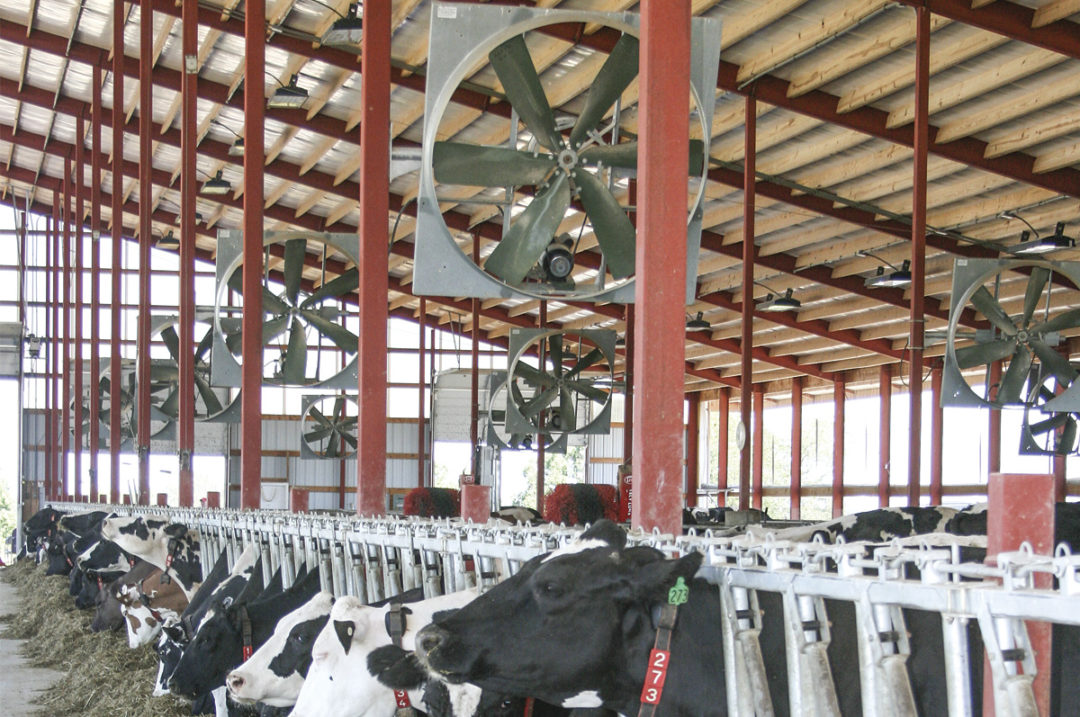Spring is finally here, which means it’s time to begin thinking about minimizing heat stress for your cows over the next several months.
Keeping your cows cool and comfortable in hot weather is important for achieving optimal milk production, but cow cooling is usually also associated with a big spike in your electricity use. Rather than view your annual summer spike as an inevitable, you can implement some energy-saving practices that will cut down on your electric bills.
Fans
There are several ways you can decrease the energy use of the fans used to cool your cows.
Thermostatic fans are programmed to turn on and off based on the ambient temperature, thus eliminating unnecessary fan use. Many dairies err on the side of caution by running fans longer than necessary to avoid overheating cows, but a fan control takes the guesswork out of this process.
Fan controls can also stage fans to achieve a desired air flow at certain ambient temperatures.
We recently worked with a farm that installed thermostatic controls for fans that typically run 24 hours per day for five months. Initial calculations indicate the farm could save more than a third of the energy used to run these fans.
Proper fan maintenance is a low-cost way to improve the efficiency of your fans. Periodically clean your fan blades and maintain belt tension on your belt-driven fans. Dirty, dusty fan blades are less efficient than clean blades. Loose belts also drop the efficiency level, although be careful about tightening too much because that can cause extra wear on the bearings.
Keeping your fan blades clean has been shown to increase fan efficiency by 10 percent or more and also increases the useful life of your fans. For example, if you have 50 standard-efficiency, 48-inch panel fans running 14 hours per day for four months, you would be saving about 8,500 kilowatt hours of electricity per year.
If your electric rate is $0.15 per kilowatt hour, that’s $1,275 saved annually. Not bad for spending a little extra time on preventative maintenance.
Sprinkler systems
Many dairies use evaporative cooling using a combination of sprinklers and fans. Although sprinkler systems have few moving parts, annual cleaning is still recommended to maximize their effectiveness. Soaking the nozzles in a cleaning solution will help remove mineral buildup from hard water and remove debris, thus increasing efficiency.
Innovative technologies
There are some innovative approaches to cow cooling that could help dairies with relief from cow cooling costs in the near future.
Conductive cooling is a newer technology that uses heat exchanger pads buried within each stall to circulate cooled water or glycol. Contact between the heat exchanger and cow bedding creates heat transfer through conduction, effectively drawing the heat from the cow through the bedding and into the cooling fluid.
Closed-loop conductive cow cooling systems can reduce electricity consumption by lowering the demand on ventilation fans by reducing run-times during peak load periods. They also have the potential to significantly reduce water consumption used for cow cooling through recirculation.
This technology is still in the development phase, but initial research presents very promising energy and water savings. The water savings may make this technology especially pertinent if your dairy is located in a drought-prone area.
Variable-frequency drives (VFDs) for fans save electricity by automatically adjusting the operating speed of fans based on the difference between the current air temperature and the desired air temperature.
If the ambient temperature is close to the set-point temperature, VFDs will reduce the demand of electricity by the fan motor by decreasing fan speed. VFDs can be installed on existing ventilation systems or installed as an integrated component of individual fans, and they can be used to control individual fans or multiple fans.
Fan VFDs have not been widely implemented within the dairy sector, but research is actively underway to better understand the energy savings of this approach and the effect on animal health.
Because cow cooling is such a large energy use on dairies, you can be sure to see even more innovative approaches developed in the coming years. In the meantime, keep in mind some of the existing ways to cut your energy costs. If you are looking to replace fans, make sure to seek out the most efficient model possible.
BESS Labs at the University of Illinois has an online searchable database for comparing manufacturers and models based on efficiency and other factors. Because the energy used for cow cooling can vary widely between dairies, an energy audit can also help analyze the unique energy-use profile of your dairy and recommend customized options to reduce your costs.
Keeping your cows properly cooled in the summer doesn’t have to be as expensive as you may be thinking. Keep these tips in mind as you gear up for the new season and for making changes on your dairy, and you will soon be able to keep more money in your pocket.
PHOTO: Proper fan maintenance is a low-cost way to improve the efficiency of your fans. Periodically clean your fan blades and maintain belt tension on your belt-driven fans. Dirty, dusty fan blades are less efficient than clean blades. Loose belts also drop the efficiency level, although be careful about tightening too much. Staff photo.







